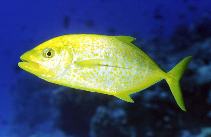Flavocaranx bajad (Fabricius, 1775)
Orangespotted trevally
Upload your photos and videos
Pictures | Videos | Google imageFlavocaranx bajad
Picture by Patzner, R.
Pictures | Videos | Google imageFlavocaranx bajad
Picture by Patzner, R.
Classification / Names Nomi Comuni | Sinonimi | Catalog of Fishes(Genere, Specie) | ITIS | CoL | WoRMS | Cloffa
> Carangiformes (Jacks) > Carangidae (Jacks and pompanos) > Caranginae
Etymology: Flavocaranx: Name from Latin 'favo' meaning 'yellow' and Caranx, which is the type genus of Carangidae; referring to yellowish body color.
Etymology: Flavocaranx: Name from Latin 'favo' meaning 'yellow' and Caranx, which is the type genus of Carangidae; referring to yellowish body color.
Environment: milieu / climate zone / depth range / distribution range Ecologia
marino associati a barriera corallina; distribuzione batimetrica 2 - 70 m (Ref. 90102). Tropical; 35°N - 8°S, 33°E - 150°E
Distribuzione Stati | Aree FAO | Ecosystems | Presenze | Point map | Introduzioni | Faunafri
Indo-West Pacific: Red Sea, Gulf of Aden, Persian Gulf, and the Gulf of Oman to Indonesia, the Gulf of Thailand, the Philippines, and Okinawa, Japan.
Length at first maturity / Size / Peso / Age
Maturity: Lm 24.7 range ? - ? cm
Max length : 55.0 cm TL maschio/sesso non determinato; (Ref. 3287); common length : 42.0 cm TL maschio/sesso non determinato; (Ref. 5450)
Max length : 55.0 cm TL maschio/sesso non determinato; (Ref. 3287); common length : 42.0 cm TL maschio/sesso non determinato; (Ref. 5450)
Short description Chiavi di identificazione | Morfologia | Morfometria
Spine dorsali (totale) : 9; Raggi dorsali molli (totale) : 24 - 26; Spine anali: 3; Raggi anali molli: 22 - 24.
Adults are common along coastal reef slopes or around large coral heads in lagoons (Ref. 48635). A xanthic form often seen in muddy bays mixes in schools (Ref. 48635). Juveniles solitary in sheltered coastal basys (Ref. 48635).
Life cycle and mating behavior Maturità | Riproduzione | Deposizione | Uova | Fecundity | Larve
Main reference
Upload your references | Bibliografia | Coordinatore : Smith-Vaniz, William F. | Collaboratori
Smith-Vaniz, W.F., 1984. Carangidae. In W. Fischer and G. Bianchi (eds.) FAO species identification sheets for fishery purposes. Western Indian Ocean fishing area 51. Vol. 1. [pag. var.]. FAO, Rome. (Ref. 3287)
IUCN Red List Status (Ref. 130435: Version 2024-2)
Least Concern (LC) ; Date assessed: 06 March 2015
CITES
Not Evaluated
Threat to humans
Harmless
Human uses
Pesca: commerciale; Pesce da pesca sportiva: si
FAO - pesca: landings; Publication: search | FishSource | Sea Around Us
Informazioni ulteriori
Population dynamics
Growth parameters
Max. ages / sizes
Length-weight rel.
Length-length rel.
Length-frequencies
Mass conversion
Reclutamento
Abbondanza
Growth parameters
Max. ages / sizes
Length-weight rel.
Length-length rel.
Length-frequencies
Mass conversion
Reclutamento
Abbondanza
Life cycle
Riproduzione
Maturità
Maturity/Gills rel.
Fecundity
Deposizione
Spawning aggregations
Uova
Egg development
Larve
Dinamica popolazioni larvali
Riproduzione
Maturità
Maturity/Gills rel.
Fecundity
Deposizione
Spawning aggregations
Uova
Egg development
Larve
Dinamica popolazioni larvali
Anatomy
Area branchiale
Brain
Otolith
Area branchiale
Brain
Otolith
Physiology
Body composition
Nutrients
Oxygen consumption
Swimming type
Swimming speed
Visual pigments
Fish sound
Diseases & Parasites
Toxicity (LC50s)
Body composition
Nutrients
Oxygen consumption
Swimming type
Swimming speed
Visual pigments
Fish sound
Diseases & Parasites
Toxicity (LC50s)
Genetics
Genetica
Heterozygosity
Ereditarietà
Genetica
Heterozygosity
Ereditarietà
Human related
Aquaculture systems
Profili di acquacoltura
Varietà
Ciguatera cases
Stamps, coins, misc.
Aquaculture systems
Profili di acquacoltura
Varietà
Ciguatera cases
Stamps, coins, misc.
Strumenti
Bio-Quiz | E-book | Giuda pratica | Chiavi di identificazione | Generatore frequenze di lunghezza | Strumento Parametri Biologici | Mappa dei ritrovamenti | Classification Tree
| Catch-MSY |
Special reports
Download XML
Fonti Internet
AFORO (otoliths) | Aquatic Commons | BHL | Cloffa | BOLDSystems | Websites from users | Check FishWatcher | CISTI | Catalog of Fishes: Genere, Specie | DiscoverLife | ECOTOX | FAO - pesca: landings; Publication: search | Faunafri | Fishipedia | Fishtrace | GenBank: genome, nucleotide | GloBI | Google Books | Google Scholar | Google | IGFA World Record | MitoFish | Database Nazionali | Otolith Atlas of Taiwan Fishes | PubMed | Reef Life Survey | Socotra Atlas | Tree of Life | Wikipedia: Go, ricerca | World Records Freshwater Fishing | Zoological Record
Estimates based on models
Preferred temperature (Ref. 123201): 25.5 - 29.2, mean 28.5 °C (based on 944 cells).
Phylogenetic diversity index (Ref. 82804): PD50 = 0.5000 [Uniqueness, from 0.5 = low to 2.0 = high].
Bayesian length-weight: a=0.01175 (0.00778 - 0.01775), b=2.92 (2.80 - 3.04), in cm total length, based on LWR estimates for this species & (Sub)family-body (Ref. 93245).
Trophic level (Ref. 69278): 4.3 ±0.59 se; based on food items.
Resilienza (Ref. 120179): Medio, tempo minimo di raddoppiamento della popolazione 1.4 - 4.4 anni (Tmax=8; K = 0.24-0.59).
Fishing Vulnerability (Ref. 59153): Moderate vulnerability (39 of 100).
Climate Vulnerability (Ref. 125649): Very high vulnerability (90 of 100).
Nutrients (Ref. 124155): Calcium = 34.6 [22.4, 75.1] mg/100g; Iron = 1.32 [0.61, 2.63] mg/100g; Protein = 20.3 [17.7, 22.4] %; Omega3 = 0.175 [0.103, 0.307] g/100g; Selenium = 11.2 [5.4, 22.9] μg/100g; VitaminA = 41.3 [7.7, 242.9] μg/100g; Zinc = 0.69 [0.38, 1.54] mg/100g (wet weight);




